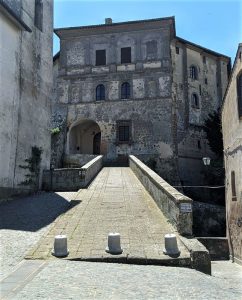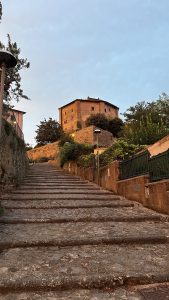- admin
- Nov, 09, 2024
- Places to visit
- Commenti disabilitati su 5. Rocca Farnese


The imposing fortress of Capodimonte, with its elegant octagonal plan, is the jewel of the town. Originally, it was a military palace belonging to the Barons of Bisenzio, later transformed by the Farnese family, at the behest of Pier Luigi Senior, towards the end of the 15th century into a summer residence and representation site. In 1513-1514, commissioned by Cardinal Alessandro Farnese, Antonio da Sangallo the Younger restored the building, adding a Renaissance loggia facing the lake, a drawbridge, and four defensive bastions.
The drawbridge was later replaced by a masonry bridge. The structure is characterized by a unique “cordonata” in bricks that allowed knights to reach the top floor of the fortress without dismounting. The central courtyard, also embellished by Sangallo, features a double order of arcades, giving the fortress the appearance of a Renaissance villa.
With the increasing political power of the Farnese family, all their residences, including the Rocca di Capodimonte, were expanded and adorned with gardens and frescoes.
Among the original decorations of the Rocca remains a fresco in the main hall dated 1526-1528, depicting a symbolic investiture of young Ranuccio Farnese—an event that never actually took place.
The octagonal shape of the Rocca reflects the Renaissance style typical of many Farnese residences, such as Palazzo di Caprarola and Torre di Marta.
At the foot of the Rocca lies a hanging garden created between the 19th and 20th centuries that hosts exotic plants like magnolias and Japanese sophoras, along with traces of an ancient grove of holm oaks.
The peak splendor of the Rocca occurred under Alessandro Farnese, who was elected Pope Paul III in 1534. The Rocca became an official residence in the Duchy of Castro, particularly suitable for hunting and fishing as well as hosting illustrious guests. However, following Pier Luigi Farnese’s violent death in 1547 and the subsequent decline of the Duchy of Castro, the Rocca lost its significance.
After the destruction of Castro in 1649 by order of Pope Innocent X, the territory passed into the Church’s patrimony and fell into oblivion. In the 19th century, the Rocca was purchased by the Brenciaglia brothers, whose heirs still own parts of it today. Currently, the Rocca is privately owned, and visits are allowed upon request, limited to certain areas and the Italian garden.
NOT TO BE MISSED – THE STORY OF BEAUTY AND THE BEAST, CLICK HERE FOR MORE DETAILS
